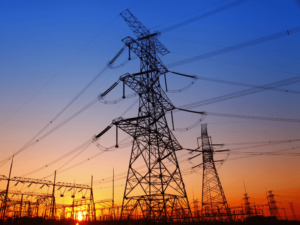

HUMAN CONTINUITY PROJECT™ PUBLICATION:
1st Quarter 2023
What Is The Problem?
COVID-19. The global energy crisis. Expanding weather disasters. Species dying out. War. Near grid-scale power outages. The 2022 international food crisis. Global hyperinflation.
Our civilization is facing serious, growing challenges. The fragile network of tightly interdependent infrastructures, resources, and supply chains that sustain our communities and our lives is at risk.
And, unfortunately, more extreme threats are waiting in the wings: in the form of Black Sky hazards; from a Carrington-class solar storm to megaquakes to extreme cyber-attacks, EMP attacks, and focused grid attacks.
Our world’s unprecedented, fast-growing interdependencies have transformed these challenges into a serious threat to human continuity. If we are unprepared, these hazards risk irreversible, systemic disruption of modern civilization.
For simplicity, we can refer to this risk as the interdependency crisis.
The Interdependency Crisis
 The infrastructures, resources, and supply chains we depend on work because today’s technology provides them with immediate access and connectivity. This, of course, is ideal for efficiency. It also makes it possible for new infrastructures, resources, and software to tie into the interconnected mix and, in turn, become interdependent. The result is that the entire system tends to grow, and become increasingly complex.
The infrastructures, resources, and supply chains we depend on work because today’s technology provides them with immediate access and connectivity. This, of course, is ideal for efficiency. It also makes it possible for new infrastructures, resources, and software to tie into the interconnected mix and, in turn, become interdependent. The result is that the entire system tends to grow, and become increasingly complex.
So, what’s the bad news?
This tech-enabled global-wide interdependency is very new, opening the doors for some things to go wrong.
As new elements merge into this system, they gradually become essential to the operation of all the others. In other words, if the whole system fails, so does our modern civilization. They stand or fall together.
How Do Other Interdependent Systems Handle This Risk?
Biological systems are a great example. They are complex, with many tightly connected components. So, how do these interdependent systems survive?
In our body, this risk is dealt with through a sophisticated, resilience system, known as our immune system. Unfortunately, our world doesn’t have one. And we can’t wait for the millions of years and evolutionary pathways it took nature to develop them.
If we wish to survive in the long run, we’ll need to build a resilience system ourselves. And that begins by developing the necessary black sky resilience tools.
The 1st Step
The ultimate goal is to develop a resilience system that can operate and self-evolve within our interconnected critical infrastructures. Among other features, it will also need to bring serious financial benefits that will encourage our economies to use it.
That’s a great long-term vision, right?
But what is the starting point? What are the immediate priorities that can be addressed today? We have no idea how long we have until a crisis exceeds the threshold of our interdependent infrastructures. Therefore, we must do what we can to prepare ourselves now.
Solving the Problem
 Since this concern is inherent in the expanding structure of our civilization, the solution will, in turn, need to be built into that structure, so that it will continue to function as long as our civilization lasts – becoming, in fact, vital to the continuity of our civilization.
Since this concern is inherent in the expanding structure of our civilization, the solution will, in turn, need to be built into that structure, so that it will continue to function as long as our civilization lasts – becoming, in fact, vital to the continuity of our civilization.
Thus, by definition, it will need to become a global scale effort, with participation by most corporations and nations, and with built-in features enabling it to evolve and improve.
But how do we get there?
The Starting Point: High-Priority Black Sky Resilience Tools and Capabilities
While the effort will need to rapidly develop, guided by a comprehensive systems engineering analysis of the most urgent priorities, we need a few key elements as a starting point.
One of the most obvious of these is the need for widely deployed, black sky resilience tools that can fill the most severe gaps we must resolve to enable meaningful recovery from a massive-scale infrastructure collapse.
Based on years of consultation among leading infrastructure corporations, government agencies, and researchers from across the world, we have a good understanding of the most urgent priorities:
Black Sky Resilience Tools: Communications
 In a Black Sky scenario with one of the world’s major nations experiencing a grid-wide power outage, grid restart and restoration would be a task of weeks to months, not hours or days – far beyond the span of time that cell phone systems, internet services, and related communications will operate.
In a Black Sky scenario with one of the world’s major nations experiencing a grid-wide power outage, grid restart and restoration would be a task of weeks to months, not hours or days – far beyond the span of time that cell phone systems, internet services, and related communications will operate.
Yet restart and restoration in such a scenario will be impossible without the widest possible, reliable communications, spanning operators of all relevant power companies, their suppliers, and the operators and suppliers of the many sectors and commercial and government organizations with which the power industry is tightly interdependent.
Solution
To meet this need, a Black Sky-class communication system must be operable without connectivity to the power grid. It will need to be capable of interconnecting with any functioning emergency communication systems that any organization has available and will need to be capable of forming a “backbone” that can interconnect all such systems.
This means it must be capable of high data rate performance since it would become the one operating network tying together operators across the outage region.
In that regard, its RF component must have both unlimited scalability and a capability for “spectrum harvesting” to efficiently utilize all available spectrum channels for the duration of the emergency. And, of course, it will need to have built-in best-in-class cyber protection, EMP protection, and protection against other Black Sky hazard scenarios.

Example
EIS Council has developed the BSX Emergency Coordination and Communication System to address this need. We have also hosted deployment and multi-state testing of the foundational layer of that system, the BNET emergency communication system manufactured by RAFAEL Corporation. The system is now in initial deployment at some of the most critical facilities in a leading power company in the United States and is in evaluation by other power companies and US government agencies.
Black Sky Resilience Tools: Chaos Management
In an extreme Black Sky scenario, with all infrastructures disrupted or shut down on subcontinental scales, operators in every major infrastructure sector will face countless urgent problems and potential actions vastly beyond the experience of “conventional” disasters.
Let’s assume, first, that a Black Sky-class emergency communication system is available. Nevertheless, even basic situational awareness will be difficult to acquire, especially for corporations and sectors outside the direct responsibility of an operator. In fact, even if an operator had such visibility, the array of urgent problems and relevant potential actions and their likely direct and indirect consequences will be far beyond any human capacity to assess. Yet timely assessment of the current status of an operator’s system and all those indirect systems it depends on, and timely, carefully prioritized actions, will be essential for each operator to play their part in sustaining affected communities.
In such scenarios, the only hope for successful management of the chaos would be the availability of an AI-enabled situational awareness and decision support system in tight functional connectivity with the operating systems of all interdependent infrastructures, resource networks, and suppliers and capable of racing through countless action/consequence scenarios at computer speed.
Solution
Meeting this need requires a situational awareness and decision support platform capable of interconnecting an essentially unlimited number of corporations and other stakeholders. The platform can then be structured to use interchanged functional information with AI-enhanced algorithms, providing operators in every sector with the visibility and the recommended, prioritized actions that will enable them to best sustain the affected population.
Example
EIS Council is developing GINOM®, an innovative AI-enhanced Multicorporate Operating System (MOS), to address this mission. Now operating in early prototype mode, with seamless design, the system utilizes any available servers and provides multiple operators with unique situational awareness and decision support guidance. It employs only functional information, with no need for proprietary or sensitive data from participating infrastructure corporations.
 The platform is structured to evolve into a national catastrophe resilience analysis, planning, and real-time decision support hub. With its access to real-time information from all participating corporations, GINOM examines the consequences of all possible scenarios at computer speed, providing each user with a customized, optimized action plan.
The platform is structured to evolve into a national catastrophe resilience analysis, planning, and real-time decision support hub. With its access to real-time information from all participating corporations, GINOM examines the consequences of all possible scenarios at computer speed, providing each user with a customized, optimized action plan.
Black Sky Resilience Tools: Long Duration Uninterruptible Power System (UPS) – LDU Module
Grid restart operations (blackstart) in a large-scale grid outage are complex. Under ideal conditions, the timeline required for such a process would be weeks at best. During that period, most facilities will have no grid power available. Yet while most important facilities have provisions for emergency power, these systems typically are fueled to enable operations for hours, or at most a day or two. In the chaos associated with a large-scale disaster, refueling will be impossible for countless critical facilities. The demand for emergency fuel resupply will be massive. And the supply and availability? Severely disrupted.
In other words, to play any role in restoration and recovery, facilities will require an interim LDU module as a power solution that can power a facility’s most vital instruments and assets for many weeks or longer. And given the ubiquitous need that exists for such modules, ensuring the power sources have no carbon effluent will be key for any deployment.
The incidence of Black Sky events will be infrequent, so we must design these systems to enable long-duration storage without requiring fuel replacement or heavy maintenance.
Solution
Based on the need, if they wish to be capable of participating in recovery following a Black Sky scenario, significant corporate or government facilities of nearly any size will require LDU modules to supplement their existing emergency power capabilities.
Typically, these modules will provide auxiliary power for a minimum of a month duration, with the size configured to support only a facility’s most critical instruments, sensors, valves, and related systems. Since potential scenarios include EMP strikes, these modules must also be EMP protected.
To provide a rough sense of sizing, a range of 5-20 Kw would likely span the needs for the most essential instrumentation of most facilities. Where space is available, deployment of additional modules could allow for scaling.
Example
After reviewing many different options, we are recommending the deployment of the GenCell liquid ammonia-based LDU Modules. These systems can meet the power requirements with fully enclosed, self-contained systems that can continuously supply power of the required levels for a month or, depending on footprint, for six months or longer. 
These systems have no carbon effluent, need little maintenance, and do not require fuel replacement when stored for months or even years. The size of such systems is typically comparable to the propane tanks often used for emergency power for a day or so at power substations. They are commercially available and currently deployed at a wide variety of facilities in the US, Europe, and elsewhere.
Black Sky Resilience Tools: Enabling Black Sky-Class Restart for the Evolving Grid
Blackstart restoration, the ability to restart the power grid from inside a blacked-out area without externally provided power, is becoming increasingly important for grid resilience. Indeed, for the extraordinarily wide-area blackouts that Black Sky events will entail, blackstart will be the only alternative for grid restart.
Yet blackstart capabilities are at increasing risk worldwide. Three problems contribute to this risk, all of which will require innovative strategies and policy initiatives to overcome:
-
Blackstart is a Key Vulnerability to Adversary Attack
A significant aspect of the urgency for grid restart capabilities comes from a sense of increasing risk of infrastructure attacks. Yet among the most likely targets of such attacks are the core elements of the grid that form the backbone of blackstart networks.
-
Regulatory Policy is Disincentivizing Blackstart Capacity
Increasingly, research by many organizations suggests that power companies find they have significant financial disincentives to make generating stations available as blackstart facilities. Given how critical these facilities will be in Black Sky scenarios, it will be important to find ways to reverse this trend.
-
Few Nations Have Developed Blackstart Policies for the “Green” Transition
In the US, for example, no policies exist to maintain US blackstart resilience capabilities as the nation transitions toward a greener grid.
Solution

Historically, black sky events have been a rare occurrence. While this is great, it also means that blackstart capabilities have not been practiced enough.
With this in mind, it is unsurprising that policies guiding such capabilities, not to mention technical features of blackstart facilities, are inadequate.
As the grid transitions to far greater use of renewable energy, new technical guidelines and policies will be needed to account for this evolution.
Example
EIS Council is developing a new edition of the “EPRO EMP Handbook,” which provides practical guidelines addressing grid resilience needs for Black Sky scenarios.
More specifically, the new Handbook titled “EPRO Handbook V: Blackstart Restoration for a Greener Grid,” will directly address the policy and technical concerns putting blackstart at risk. EPRO Handbook V will go into detail about the concerns for today’s grid architecture and the transition to a greener grid.
This new resource is being developed by leading experts in the electricity, security, and regulatory sectors providing regular input and review.
Are you an expert in grid technology, or another related field? Wish to be involved in this review? Then write to info@eiscouncil.org for more information.
Create Impact with us:
Join our membership and
contribution programs
Participate in our
upcoming events:
Schedule a call with
our experts:
Advancing Earthquake Resilience: Strategic Urban Planning and Global Partnerships
In an era where urban landscapes continue to sprawl and the frequency of natural disasters seems to be on the rise, the importance of building resilient cities has never been more pronounced. Earthquakes, in particular, pose a significant risk to densely populated areas, with the power to cause extensive damage and incur millions in damage […]
Cyber Resilience in the Energy Sector: Safeguarding the Grid from Digital Disruptions
In today’s interconnected world, the energy sector stands as a vital backbone of national and global infrastructures, facilitating everything from lighting our homes to powering industries. However, this sector is increasingly finding itself in the crosshairs of cybercriminals, making cyber resilience not just a matter of technological integrity but of national security. The concept of […]
The Role of Local Governments in Strengthening Infrastructure Resilience
The significance of local governments in strengthening infrastructure resilience cannot be understated. Often perceived as entities primarily focused on addressing routine community concerns and improvements, their responsibilities extend far beyond these day-to-day operations. In the realm of preparing for and mitigating the effects of large-scale, catastrophic events—referred to as “black sky” disasters—local governments emerge as […]
